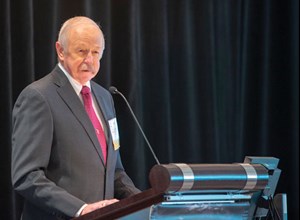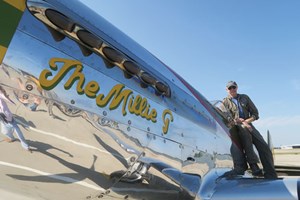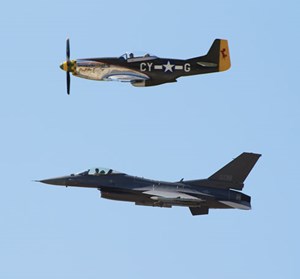Trent Latshaw recognized with IADC’s highest honor
On Nov. 9, 2018, at the IADC Annual General Meeting held in New Orleans, Trent Latshaw, president of Latshaw Drilling Co. and a World Oil editorial advisor, was named 2018 IADC Contractor of the Year, Fig. 1. The award recognizes individual drilling contractors and their outstanding lifetime achievements. This award is the only one in the industry dedicated to drilling contractors and is sponsored by National Oilwell Varco (NOV). All recipients are nominated and selected by IADC drilling contractor members.

Latshaw is a 1975 graduate of Texas A&M University and holds a bachelor’s degree in petroleum engineering. After graduation, he went to work at Parker Drilling in Alaska, serving as a roughneck, motorman, derrickman and relief driller, both onshore and offshore. He then worked for ARCO Alaska as a drilling engineer and drilling foreman in the company’s offshore operations, which covered the Gulf of Alaska and Cook Inlet.
The founding. In 1981, at the age of 28, Trent founded Latshaw Drilling Company and built two new 20,000-to-25,000-ft diesel-electric/SCR land rigs. His family now says that no one should have been surprised by this, because at age 18, as he was first entering Texas A&M, he had set as his personal goal to one day become a reliable and dependable drilling contractor. Indeed, Trent and his firm were well on their way to that goal, when oil prices crashed in early 1986.
Like many, Trent says the ensuing depressed energy price years, which extended through 2000, provided a great “flour sieve” of who could be creative enough to survive. Those years were spent in acquisition and sales of a myriad of drilling rigs and equipment that became available through repossessions and liquidations conducted by financial institutions and at auctions. Between 1986 and 1992, he bought, for just $5 million, 10 complete drilling rigs and other major components that originally had a combined, new replacement cost of over $100 million. Also, during 1996 and 1997, he acquired oilfield equipment manufacturers Mathey-Leland (wireline units) and Cooper Manufacturing (well-servicing rigs), both now part of NOV.
Major growth. So, it was not until 2003, when the industry had worked through the surplus of equipment, that Latshaw Drilling resumed drilling operations. Those operations began with a 1,000-hp mechanical rig. In 2005, Trent began building new diesel-electric/SCR rigs. By 2012, he had built the company up to 17 rigs. The notable acquisition of Keen Energy Services in October 2012 more than doubled Latshaw Drilling’s size. Over a nine-year period from 2003 to 2012, the company grew from one rig and 23 employees to 41 rigs and more than 1,000 employees. Latshaw Drilling is now the second-largest privately owned drilling contractor in the U.S.

Over the years, while building his company, Trent ascribes much of his success to leadership rules that he has developed and lived by, the cornerstones of which are trustworthiness and credibility. He says that leaders need to communicate to their people that they believe in their abilities. “Leaders don’t have all the answers,” he says. “Rather, ask great questions. And, if people don’t trust you, they will not follow you.” On earning credibility, he says that one must be honest, and must align actions with words. “Do what you say you are going to do.”
Aviation. In addition to chairing the IADC Houston Chapter in 1991, Trent currently serves on the IADC North America Onshore Advisory Panel and the IADC Executive Committee. He also serves on the Board of Directors of the Tulsa Air and Space Museum. The latter post is a manifestation of his life-long fascination with aviation, which saw him get his first pilot’s license at age 18 in 1971. Since then, not only has he become an expert pilot, but he has acquired and operates two World War II-vintage airplanes, a P-51 Mustang nicknamed “The Millie G,” Fig. 2, and a Vought F4U-4 Corsair. The P-51 was acquired in 2007, and the Corsair was added in 2013.

In 2012 and 2013, Trent brought the P-51 to College Station, Texas, the home of Texas A&M, for students to tour. And on Sept 16, 2017, he got a chance to fly the P-51 in a “heritage formation” flight (Fig. 3) with an F-16 fighter of the Tulsa-based 138th Fighter Wing of the Oklahoma National Guard, in celebration of the unit’s 25 years of operating the latter aircraft. The first F4U flew in 1940, and it was designed with folding wings for storage on aircraft carriers. It also became popular with U.S. Marine and British squadrons based on land.
Back in 2014, Trent explained to Tulsa television station KOTV that he’s gotten used to people telling him that the F4U-4 Corsair is their favorite airplane, but he hasn’t gotten used to the effect that it has on him when he flies it, and that he probably never will. “I was flying home from Fort Worth a few weeks ago. It was about 7 p.m., and I was above the clouds with the sun off to the left. The sun was reflecting off the wing and the tips of the prop. ‘How neat is this?’ I asked myself. I’m flying a piece of history.”
Community. Trent and his wife, Bonnie, have been involved with a number of worthy non-profits and charities over the years, including the Tulsa Air and Space Museum (TASM), and the Stafford Air & Space Museum in Weatherford, Okla. They also got past some medical scares in 2016 and 2017. Bonnie was diagnosed in 2016 with lung cancer, but that diagnosis was later proven in early 2017 by the Mayo Clinic to be incorrect. Meanwhile, Trent underwent surgery in October 2016 for a mitral valve problem, and then another heart surgery was needed about a year later. He has since made a full recovery.
Trent’s career has earned him the respect and praise of many colleagues. “Trent had a goal/dream to own a drilling company,” says Loren Singletary, chief investor and industry relations officer at NOV. “He accomplished his goal at a very young age with hard work and perseverance. Throughout his career, Trent has guided his company with integrity and honesty. He has dedicated his life to his company, and the oil and gas industry. I have been very fortunate, for the past 40 years, to call Trent Latshaw a friend.”
And at TASM, fellow board member Bill Christianson (of Christianson Aviation) says that “not only is Trent a great oilman, he is a great aviator. He has become Mr. Warbird in Tulsa. Trent is a tremendous asset on the TASM board, not only because he is a great aviator, but a great businessman, who asks all the right questions. TASM appreciates everything that Trent has done and continues to do.”. ![]()

- Applying ultra-deep LWD resistivity technology successfully in a SAGD operation (May 2019)
- Adoption of wireless intelligent completions advances (May 2019)
- Majors double down as takeaway crunch eases (April 2019)
- What’s new in well logging and formation evaluation (April 2019)
- Qualification of a 20,000-psi subsea BOP: A collaborative approach (February 2019)
- ConocoPhillips’ Greg Leveille sees rapid trajectory of technical advancement continuing (February 2019)


